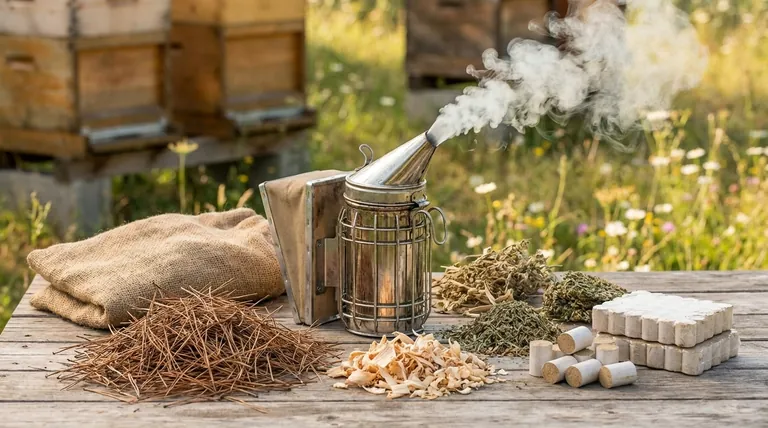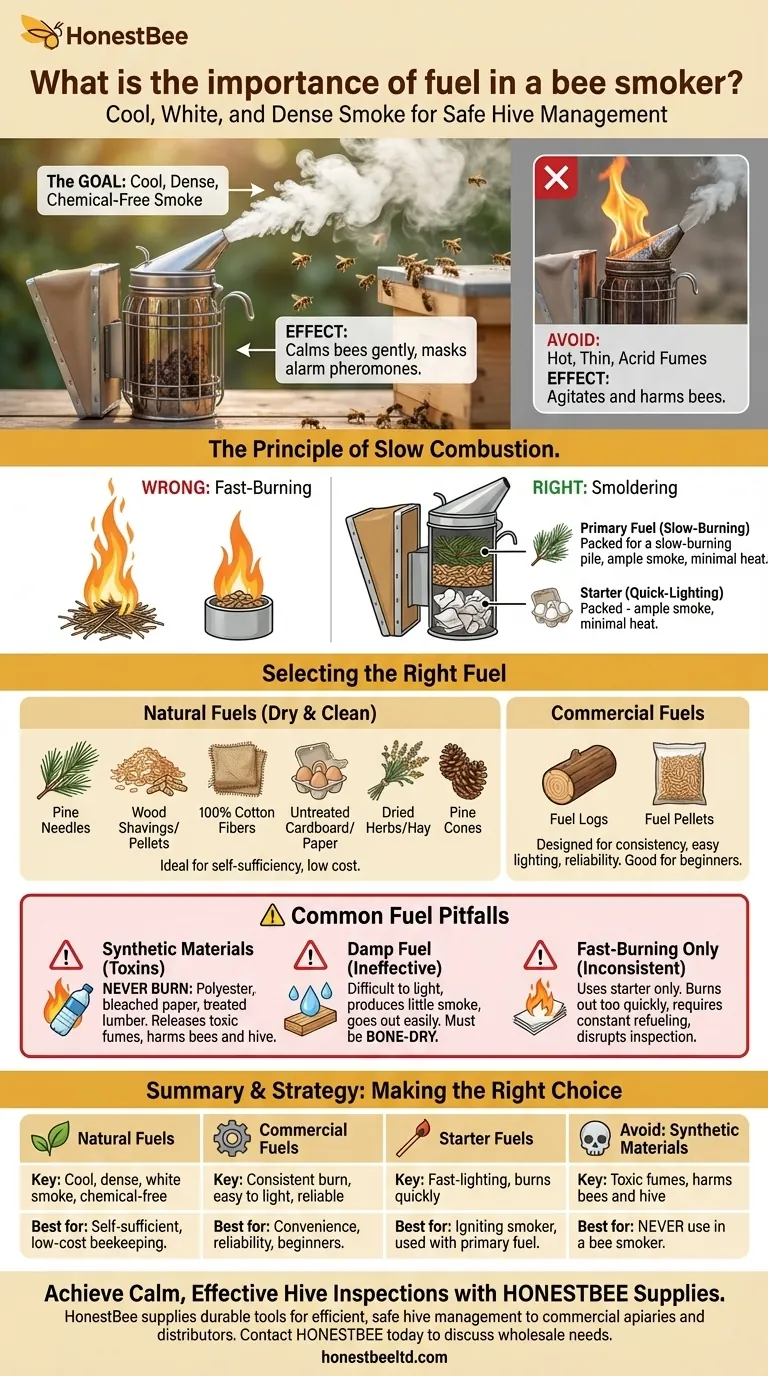The fuel you choose for your bee smoker is as important as the smoker itself. The entire purpose of a smoker is to produce a specific kind of smoke—cool, white, and dense—that safely calms the bee colony. The right fuel achieves this effect efficiently, while the wrong fuel can be ineffective, agitate the bees, or even introduce harmful toxins into the hive.
Effective hive management isn't just about using smoke; it's about using the right smoke. The goal is to produce a cool, dense, and chemical-free smoke that triggers a natural response in bees, not to harm or agitate them with hot, acrid fumes.

The Role of Fuel in Bee Behavior
The quality of your smoker's output directly impacts its effectiveness. The fuel is the source of this output, and understanding what makes a fuel "good" is critical.
Why Cool, White Smoke is the Goal
Hot, thin smoke from an open flame will agitate and harm your bees. The objective is smoldering, not burning.
A slow-burning, properly packed fuel produces a thick, cool smoke. This smoke is gentle on the bees' delicate wings and respiratory systems and effectively masks the alarm pheromones they release to signal danger.
The Principle of Slow Combustion
Good smoker fuel doesn't burn quickly with a tall flame. Instead, it should be packed to create a slow-burning pile that produces ample smoke without excessive heat.
This is often achieved by using a fast-lighting material as a starter at the bottom and then layering slower-burning primary fuel on top.
Selecting the Right Fuel for Your Smoker
The best fuels are natural, dry, and free of any chemicals, glues, or synthetic materials. Consistency is key to a calm hive inspection.
Recommended Natural Fuels
Many effective fuels can be found for free. The key is ensuring they are completely dry and clean.
Excellent choices include:
- Pine Needles (a beekeeper favorite)
- Wood Shavings or Pellets (untreated)
- 100% Cotton Fibers (such as burlap, old t-shirts, or untreated twine)
- Untreated Cardboard or Paper (egg cartons are ideal)
- Dried Herbs, Grass Clippings, or Hay
- Pine Cones
Commercial Fuel Options
For convenience and reliability, many beekeepers use specially made commercial fuels.
These products, often sold as logs or pellets, are designed to light quickly and burn for a consistent, extended period. They are an excellent option for beginners or for beekeepers who need to get a smoker going efficiently.
Understanding the Trade-offs: Common Fuel Pitfalls
Using the wrong fuel is one of the most common mistakes a beekeeper can make. It not only leads to a difficult hive inspection but can also cause serious harm.
The Hazard of Synthetic Materials
Never burn synthetic materials. This includes polyester fabric, bleached paper, treated lumber, or anything containing plastic, glue, or ink.
These materials release toxic fumes when burned, which can kill your bees and contaminate the honey and wax in the hive.
The Problem with Damp Fuel
Fuel must be bone-dry to work properly. Damp or "green" fuel is difficult to light, produces very little smoke, and is likely to go out in the middle of a hive inspection.
Fast-Burning vs. Slow-Burning
Materials like paper or cardboard light easily and make a great starter. However, they burn out far too quickly to be used as a primary fuel source.
Using them alone will result in inconsistent smoke and require you to constantly stop and add more fuel, disrupting the inspection and agitating the hive.
Making the Right Choice for Your Goal
Your fuel strategy should be simple, reliable, and safe for your bees. Combine materials to create a long-lasting, cool smoke.
- If your primary focus is convenience and reliability: Start with commercial fuel pellets or logs for a consistent, easy-to-manage smoke.
- If your primary focus is self-sufficiency and low cost: Use readily available natural materials like dry pine needles, untreated burlap, or wood shavings from your workshop.
- If you are a beginner learning the process: Combine a quick-lighting starter like an egg carton with a slower-burning primary fuel like pine needles or cotton fibers layered on top.
Mastering your smoker fuel is a fundamental step toward becoming a calm, confident, and effective beekeeper.
Summary Table:
| Fuel Type | Key Characteristics | Best Use Case |
|---|---|---|
| Natural Fuels (e.g., pine needles, burlap) | Cool, dense, white smoke; chemical-free | Self-sufficient, low-cost beekeeping |
| Commercial Fuels (pellets/logs) | Consistent burn, easy to light; reliable | Convenience, reliability, beginners |
| Starter Fuels (e.g., egg cartons) | Fast-lighting; burns quickly | Igniting the smoker, used with primary fuel |
| Avoid: Synthetic Materials | Produces toxic fumes; harms bees and hive | Never use in a bee smoker |
Achieve Calm, Effective Hive Inspections with the Right Supplies
Mastering your smoker is just one part of successful beekeeping. Equip your operation with high-quality, reliable equipment designed for commercial success.
HONESTBEE supplies beekeeping supplies and equipment to commercial apiaries and beekeeping equipment distributors through wholesale-focused operations. We provide the durable tools you need for efficient, safe hive management.
Contact HONESTBEE today to discuss your wholesale needs and ensure your apiary is equipped for peak performance.
Visual Guide

Related Products
- 54-Piece Smoker Fuel Pellets for Beekeeping Beehive Smoker Fuel
- Economy Galvanized Beekeeping Honey Bee Smoker for Wholesale
- Premium Traditional Copper Bee Smoker with Bellows
- Professional Bee Smoker with Elongated Spout and Durable Bellows for Beekeeping
- Stainless Steel Honey Bee Smoker Hive and Honeycomb Smoker for Beekeeping
People Also Ask
- How should you start the fire in a bee smoker? A Step-by-Step Guide for a Calm Hive
- What is best to burn in a bee smoker? Master the Layered Fuel Technique for Calm Hives
- What are important considerations when choosing smoker fuel? A Guide to Safe, Effective Beekeeping
- What is used in a bee smoker? Master the Best Fuels for Calm, Healthy Hives
- What to put in a bee hive smoker? A Guide to Natural, Calming Fuels



















